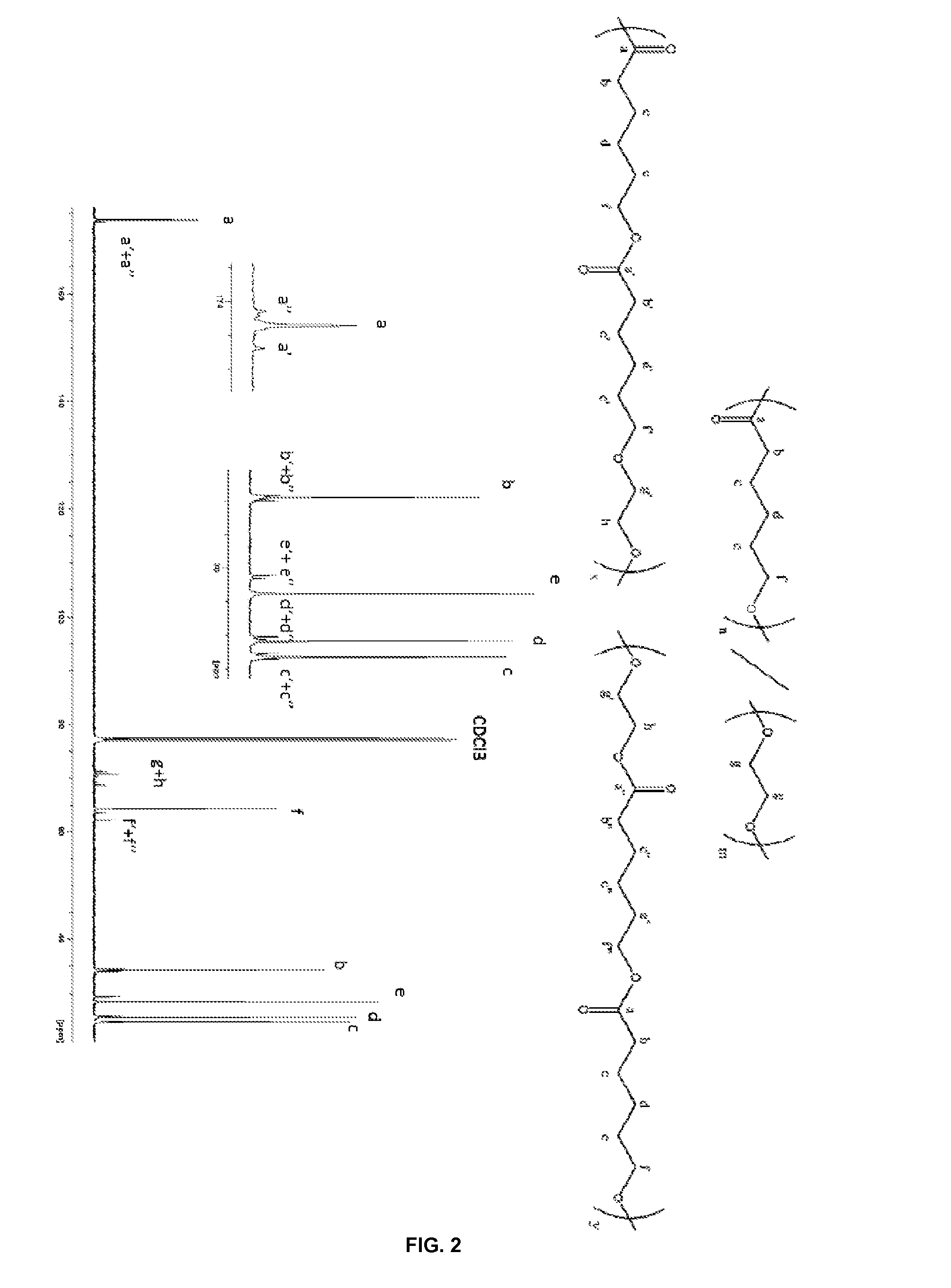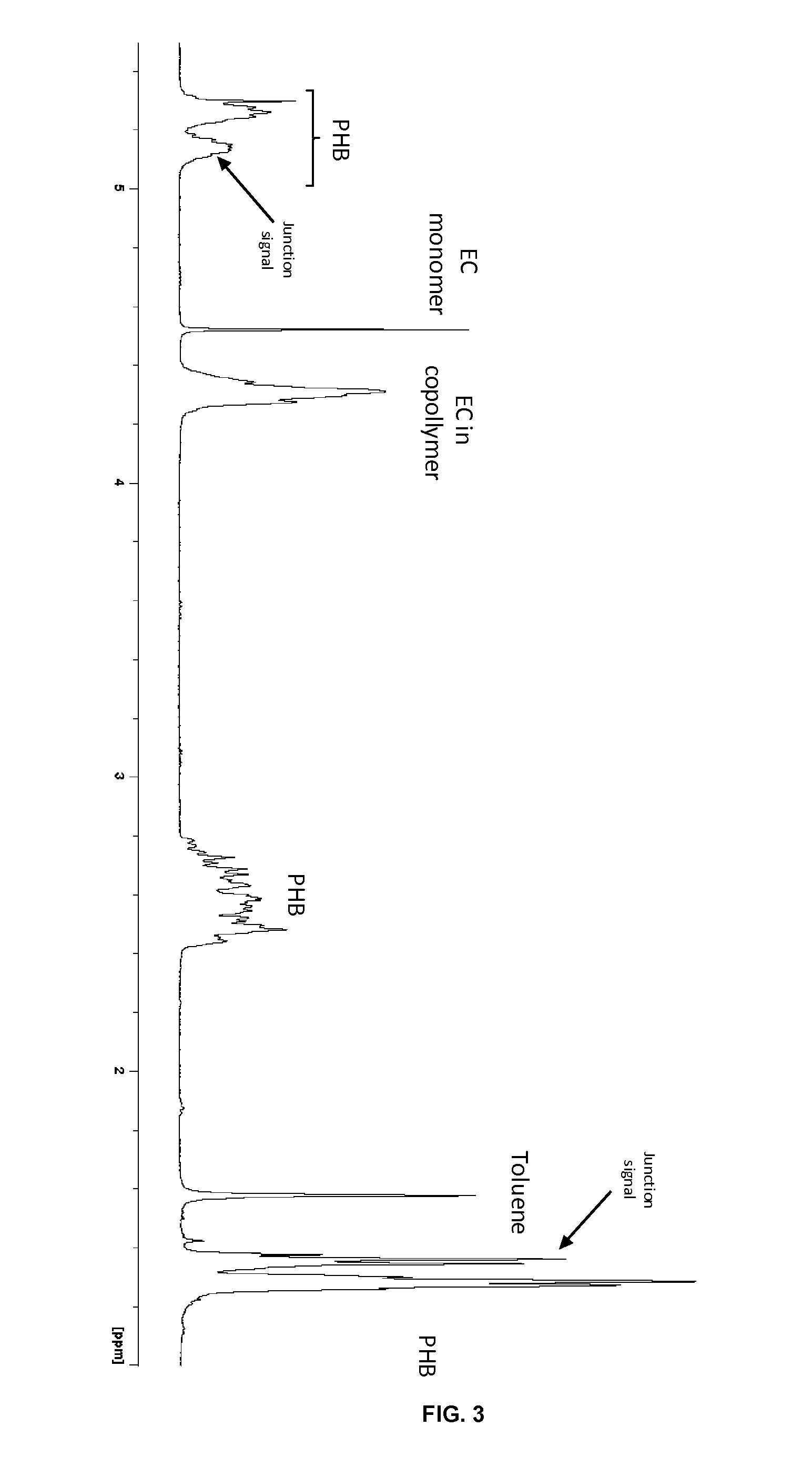Method of Copolymerizing Ethylene Carbonate with One or More Cyclic Esters
- Summary
- Abstract
- Description
- Claims
- Application Information
AI Technical Summary
Benefits of technology
Problems solved by technology
Method used
Image
Examples
example 2
Copolymerization of Ethyl Carbonate (EC) with β-Butyrolactone (BL)
[0094]The copolymerization of EC and BL was performed using the following catalytic systems: Al(OTf)3, the β-diiminate complex developed by Coates [(BDI)Zn(NTMS2)] (Chamberlain B. M., Cheng M., Moore D. R., Ovitt T. M., Lobkovsky E. B., Coates G. W.; J. Am; Chem. Soc., 2001, 123, 3229-3230), and the diaminophenolate zinc complex developed by Tolman, [(NNO)ZnEt](Williams C. K., Breyfogle L. E., Choi S. K., Nam W., Young V. G., Hillmeyer M. A., Tolman W. B.; J. Am. Chem. Soc., 2003, 125, 11350-11359). These metallic species were combined to an exogenous protic source, typically an alcohol (benzyl alcohol, BnOH), used in excess, acting both as initiator and transfer agent, so as to operate in an “immortal” ROP approach. A [catalyst]0 / [BnOH]0 ratio of 1:5 was used in the present example.
Copolymerization Procedure
[0095]In a glovebox, Tolman's zinc complex [(NNO)ZnEt](5.0 mg, 0.012 mmol) was added to a Schlenk flask prior t...
example 3
Copolymerization of Ethyl Carbonate (EC) with ε-Caprolactone (CL)
[0101]
Synthesis of PCL-co-PEC by Simultaneous Copolymerization of EC and CL
[0102]Different reactions were performed by using the catalyst Tolman's zinc complex [(NNO)ZnEt] or Al(OTf)3, which were added to a Schlenk flask prior to the addition of EC. CL was then added to the mixture. The mixture was allowed to react at the operating conditions depicted in Table 3 below.
TABLE 3Results of the EC and CL copolymerization reactions catalyzed by different systems in bulkCLmol-%TempTimeEC Conv.Conv.EC inEntryCatalyst[EC]0:[CL]0:[catalyst]0:[BnOH]0(° C.)Solvent(h)(%)(%)copolymerMnsecMw / Mn1Al(OTf)3250:500:1:2.5110—15total100ndndnddecarboxylation2(NNO)ZnEt125:250:160—42710014287001.593(NNO)ZnEt250:250:160—0.5308428507311.644(NNO)ZnEt500:250:160—1208533375351.65
[0103]Complete decarboxylation was observed when EC and CL were copolymerized by Al(OTf)3 at 110° C. Similarly to its behavior in EC / BL copolymerization, the catalytic syst...
example 4
Copolymerization of Ethyl Carbonate with δ-Valerolactone
[0107]
Synthesis of PCL-co-PEC by Simultaneous Copolymerization of EC and VL
[0108]The copolymerization between EC and δ-valerolactone (VL) promoted by the Zn-Tolman catalytic system gave a similar result, as shown in Table 4. A significant insertion (25 mol-%) of EC in the VL backbone, within a relatively short time period (1 h), was obtained.
TABLE 4Result of the EC and VL copolymerization reactions catalyzed by Tolman's zinccomplex[EC]0:[δ-VL]0:[ZnTempTimeConv. ECConv. δ-mol-% EC inEntryTolman]0(° C.)Solvent(h)(%)VL (%)copolymerMnsecMw / Mn1125:250:160—1387813ndndnd: not determined
[0109]FIG. 6 illustrates the 1H NMR spectrum (CDCl3, 400 MHz, 23° C.) of the polymer recovered from the copolymerization of EC and VL (Table 4, entry 1)
[0110]FIG. 7 illustrates the 13C NMR spectrum (CDCl3, 400 MHz, 23° C.) of the polymer recovered from the copolymerization of EC and VL (Table 4, entry 1)
[0111]The NMR analyses show also the presence of t...
PUM
| Property | Measurement | Unit |
|---|---|---|
| Temperature | aaaaa | aaaaa |
| Temperature | aaaaa | aaaaa |
| Temperature | aaaaa | aaaaa |
Abstract
Description
Claims
Application Information
 Login to View More
Login to View More - R&D
- Intellectual Property
- Life Sciences
- Materials
- Tech Scout
- Unparalleled Data Quality
- Higher Quality Content
- 60% Fewer Hallucinations
Browse by: Latest US Patents, China's latest patents, Technical Efficacy Thesaurus, Application Domain, Technology Topic, Popular Technical Reports.
© 2025 PatSnap. All rights reserved.Legal|Privacy policy|Modern Slavery Act Transparency Statement|Sitemap|About US| Contact US: help@patsnap.com



